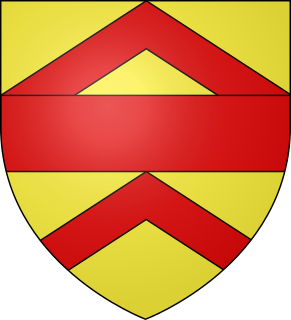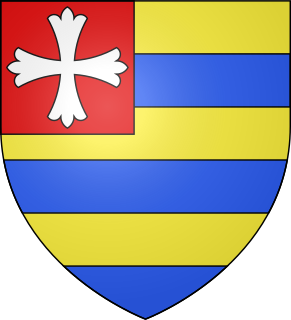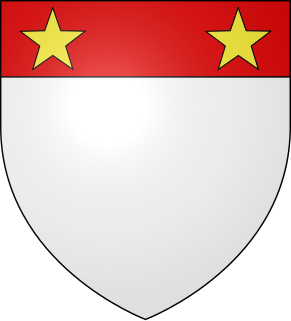
Earl of Essex is a title in the Peerage of England which was first created in the 12th century by King Stephen of England. The title has been recreated eight times from its original inception, beginning with a new first Earl upon each new creation. Possibly the most well-known Earls of Essex were Thomas Cromwell, chief minister to King Henry VIII, and Robert Devereux, 2nd Earl of Essex (1565–1601), a favourite of Queen Elizabeth I who led the Earl of Essex Rebellion in 1601.

Baron FitzWalter is an ancient title in the Peerage of England. It was created on 24 June 1295 for Robert FitzWalter. The title was created by writ, which means that it can descend through both male and female lines. His great-grandson, the fourth Baron, was an Admiral of the Fleet. The fourth baron's grandson, the seventh Baron, was succeeded by his daughter and only child, Elizabeth. She was the wife of John Radcliffe. Their son, the ninth Baron, was attainted for treason in 1495 with his title forfeited. However, his son Robert Radcliffe obtained a reversal of the attainder by Act of Parliament in 1509 and later served as Lord Lieutenant of Lancashire. He was created Viscount FitzWalter in 1525 and Earl of Sussex in 1529. His grandson, the third Earl, was summoned to the House of Lords through a writ of acceleration in 1553 in his father's junior title of Baron FitzWalter. Lord Sussex later served as Lord Deputy of Ireland. He was succeeded by his younger brother, the fourth Earl. He had earlier represented Maldon, Hampshire and Portsmouth in the House of Commons and also served as Lord Lieutenant of Hampshire. When he died the titles passed to his only child, the fifth Earl. He was Lord Lieutenant of Essex.

Earl of Carnarvon is a title that has been created three times in British history. The current holder is George Herbert, 8th Earl of Carnarvon. The town and county in Wales to which the title refers are historically spelled Caernarfon, having been Anglicised to Carnarvon or Caernarvon. The traditional Welsh spelling is itself a modified form of the original name of antiquity, Caer-yn-Arfon, meaning fortification opposite the island of Mona.
Baron Darcy de Knayth is a title in the Peerage of England. It was created in 1332 for John Darcy with remainder to his heirs general, allowing daughters to inherit.

Baron Stafford, referring to the town of Stafford, is a title that has been created several times in the Peerage of England. In the 14th century, the barons of the first creation were made earls. Those of the fifth creation, in the 17th century, became first viscounts and then earls. Since 1913, the title has been held by the Fitzherbert family.

The title of Earl of Desmond has been held historically by lords in Ireland, first as a title outside of the peerage system and later as part of the Peerage of Ireland.
Baron Ap-Adam was a title in the Peerage of England. It was created by Writ of summons to Parliament of John Ap-Adam in 1297 until his death in 1311, when the title became in abeyance.
The title Baron Bergavenny was created several times in the Peerage of England and once in the Peerage of Great Britain, all but the first being baronies created by error.

FitzMartin was the surname of a Norman family based in England and Wales between 1085 and 1342.

The title Baron Moels was created once in the Peerage of England, in 1299, and passed into abeyance with the death of the fourth lord in 1337. The four men who by modern usage are held to have been Barons Moels were:
Baron La Poer, de la Poer, or Le Pour, is a title in the Peerage of Ireland held by the Marquess of Waterford. Its creation is the sole instance in the law of the Kingdom of Ireland recognising a peerage by writ.
The Feudal barony of Cardinham is one of the three feudal baronies in Cornwall which existed during the mediaeval era. Its caput was at Cardinham Castle, Cornwall. The Barony was held in recent times by the Vivian family, the last being Nicholas Vivian, 6th Baron Vivian. Brigadier Nicholas Crespigny Laurence Vivian, 6th Baron Vivian, conveyed the title to John Anthony Vincent of Edifici Maxim's, Carrer General, Arsinal, Principat Andora, in 1995. Mr. Vincent was a member of the Manorial Society of Great Britain and died in Douglas, Isle of Man, on 31 March 2018. The Barony was then conveyed after the probate of his estate to an American citizen on 25 May 2019.
Baron Vesci was a title in the Peerage of England and Peerage of the United Kingdom. It existed as a feudal barony by tenure, before being created by Writ of summons to Parliament of John de Vesci in 1264 until his death in 1289. It was created a second time by writ of William de Vescy in 1295 until his death in 1297. It was created a third time in 1313 by writ of William de Vesci until his death in 1314. The title was created a fourth time by writ of Henry Bromflete, Lord Vescy in 1449 until it became extinct in 1469 upon his death. The title was created a fifth time for John Vesey, 4th Viscount de Vesci in 1884 until his death in 1903 when the title became extinct.

Sir William de Aton, 2nd Baron Aton, of Ayton and Malton Yorkshire was a 13th-14th century English noble. He died c. 1388.

Peter FitzHerbert, also known as Piers FitzHerbert, Lord of Blenlevenny, was a 13th and 14th century nobleman and Sheriff of Yorkshire. FitzHerbert was one of the Counsellors named in Magna Carta in 1215. He was the son of Herbert FitzHerbert and Lucy of Hereford.

Reginald FitzPiers, also known as Reynold FitzPiers, Lord of Blenlevenny was a 13th-century English nobleman and Sheriff of Hampshire. He was the second son of Peter FitzHerbert and Alice de Warkworth, and following the death of his brother inherited the minor Marcher Lordship of Blaenllynfi from him.
Baron Clavering was a title in the Peerage of England. It existed as a feudal barony by tenure, before being created by Writ of summons to Parliament of Robert fitzRoger, as Baron FitzRoger in 1295 until his death in 1310, then when the title became extinct. His son John Clavering, was created by writ of summons to Parliament as Baron Clavering in 1299 until his death in 1332.

John St John, of Basing in Hampshire, was a soldier who served as Lieutenant of Aquitaine.

John FitzReginald, also known as John FitzReynold, Lord of Blenlevenny was an English noble. He was a signatory of the Barons' Letter of 1301.
Peter FitzReginald, also known as Piers FitzReynold, Lord of Chewton was an English noble.







